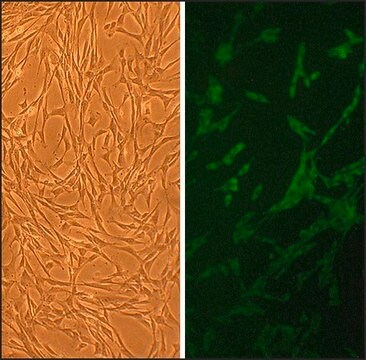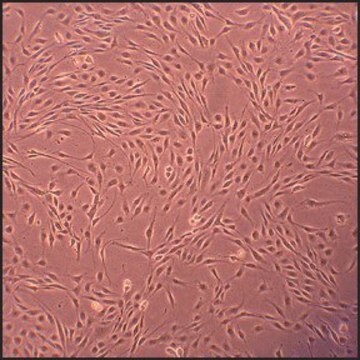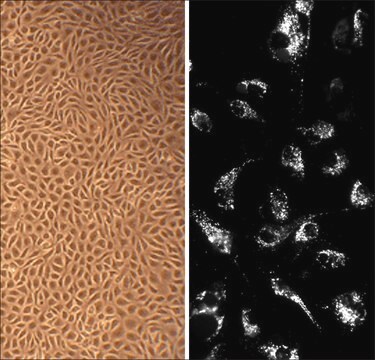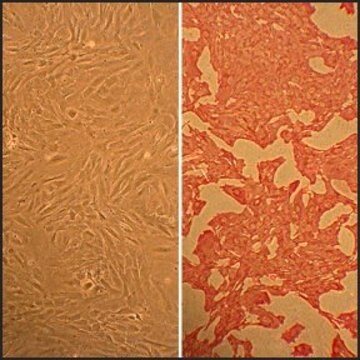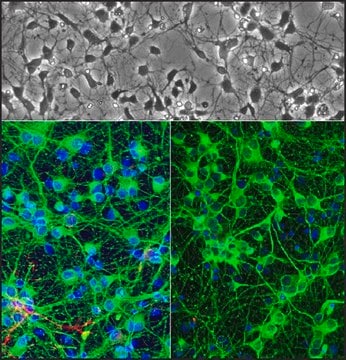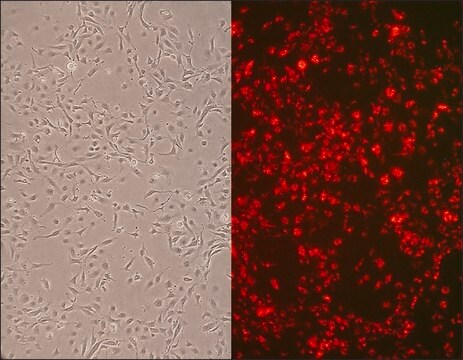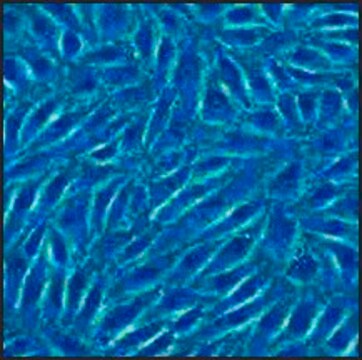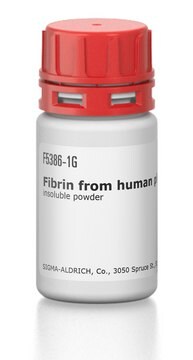CN354-05
Canine Aortic Smooth Muscle Cells: CnAOSMC (Cryovial)
About This Item
Produits recommandés
Source biologique
canine aorta (normal, tunica intima and media)
Conditionnement
pkg of 500,000 cells
Fabricant/nom de marque
Cell Applications, Inc
Mode de croissance
Adherent
Caryotype
2n = 78
Morphologie
smooth muscle
Technique(s)
cell culture | mammalian: suitable
Maladie(s) pertinente(s)
cardiovascular diseases
Conditions d'expédition
dry ice
Température de stockage
−196°C
Description générale
Canine Aortic Smooth Muscle Cells (CnAOSMC) are derived from tunica intima and tunica media of normal canine aorta. They are cryopreserved at second passage and can be cultured and propagated at least 10 population doublings. Platelet-derived growth factor (PDGF) is a potent mitogen and chemotactic agent which may be involved in intimal hyperplasia and atherosclerosis. It was shown that significant regional difference in PDGF production in normal canine aorta, and that SMC are a significant contributor to the regional variation in PDGF production.
1. It was also shown that nebivolol relaxes vascular smooth muscle by NO- and cyclic GMP-dependent mechanisms.
2. Graft SMCs are functionally altered producing more platelet-derived growth factor (PDGF) than aortic SMCs. PDGF produced by graft SMCs may contribute to the development of intimal hyperplasia.
3. Graft SMCs have decreased proliferation response, but have similar migratory response to PDGF compared with aortic SMCs.
4. Intrinsic differences in endothelial cells from proximal aorta versus the distal aorta have different capacity to produce PDGF in response to stimulants whereas unstimulated SMCs did not exhibit regional variation in PDGF production and did not increase PDGF secretion after PMA or thrombin treatment.
5. Identification of the cDNA for canine isoform of nitric oxide synthase (iNOS) can be used in the study of allograft rejection and cardiovascular disease.
RECENT PUBLICATIONS Kiyan, Y., S. Tkachuk, D. Hilfker-Kleiner, H. Haller, B. Fuhrman, and Inna Dumler. 2014. oxLDL induces inflammatory responses in vascular smooth muscle cells via urokinase receptor association with CD36 and TLR4. J Molec and Cell Cardiol, 66:72-82.
Ignarro, L.J. et al, Nitric Oxide. 7(2):75-82 (2002).
Madura, J.A. et al, J. Vas Res. 33(1):53-61 (1996).
Pitsch, R.J. et al, J. Vasc. Surg. 26(1):70-8 (1997).
Minion, D.J. et al, J. Vasc. Surg. 31(5):953-9 (2000).
Van Aalst, J.A. et al, J. Vasc. Surg. 32(3):584-92 (2000).
Wang, X. et al, Am. J. Physiol. 275(4 Pt 2):H1122-9 (1998).
Products are for research use only. They are not intended for human, animal, or diagnostic applications.
Origine de la lignée cellulaire
Application
Composants
Notes préparatoires
- 2nd passage, >500,000 cells in Canine Smooth Muscle Cell Basal Medium containing 10% FBS & 10% DMSO
- Can be cultured at least 10 doublings
Procédure de repiquage
Code de la classe de stockage
11 - Combustible Solids
Classe de danger pour l'eau (WGK)
WGK 3
Point d'éclair (°F)
Not applicable
Point d'éclair (°C)
Not applicable
Faites votre choix parmi les versions les plus récentes :
Certificats d'analyse (COA)
Désolés, nous n'avons pas de COA pour ce produit disponible en ligne pour le moment.
Si vous avez besoin d'assistance, veuillez contacter Service Clients
Déjà en possession de ce produit ?
Retrouvez la documentation relative aux produits que vous avez récemment achetés dans la Bibliothèque de documents.
Protocoles
Technical information for working with Canine Aortic Smooth Muscle Cells including thawing, subculturing and cryopreservation
Notre équipe de scientifiques dispose d'une expérience dans tous les secteurs de la recherche, notamment en sciences de la vie, science des matériaux, synthèse chimique, chromatographie, analyse et dans de nombreux autres domaines..
Contacter notre Service technique